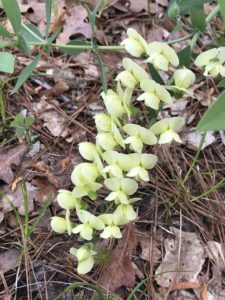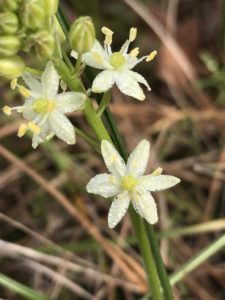A group of our hardcore students and veterans braved the weather forecast this morning and ventured out to Five Mile Prairie for the second field trip of the 2019 Class. As the caravan arrived, the weather was gloomy but the raindrops had not began to fall yet.
As we headed out, the ground was wet and boggy in places from rainfall the previous two days, but the tiny Arkansas Leastdaisy, Chaetopappa asteroides, still smiled, covering patches all along the way. Moving further in, the purple blooms of Englemann’s Milkvetch, Astragalus distortus var. engelmannii, provided a contrasting ground cover with the daisies, and light rain began to fall. We saw stunted Blackjack Oak, Quercus mirlandica, and Post Oak, Quercus stellata, that are characteristic of shallow soil overlaying the Catahoula formation in this area. We spotted several blooming Longbract Wild Indigos, Baptisia bracteata, along the way.
Finally we arrived at the treasure we were looking for. A healthy population, perhaps hundreds, of Schoenolirion wrightii greeted us. This flower is only found in Alabama, Arkansas, Louisiana and Texas. Its habitat is disappearing, and it is listed as globally vulernable. Louisiana lists it as Critically Imperiled and Arkansas as Threatened. The common names for this species of concern are Texas Sunnybells or Wright’s Lily, named after botanist and naturalist, Charles Wright, who discovered the plant during his surveys of present Jasper, Angelina, Tyler and Newton counties while he lived on the Neches River and taught school in Zavalla, Texas between 1837 and 1840. Afterwards he moved to Town Bluff and stayed several years before heading further west on botanizing ventures.
The rain began to set in then, and we slowly circled our way back until thunder began to rip the clouds directly above us. No one complained, but the pace quickened a little, and none protested when we reached the road and decided against venturing to our second planned site, Black Branch Barrens. We will reschedule a trip there, perhaps in the fall when the spectacular Nuttall’s Rayless Goldenrod, Bigelowia nuttallii, covers the barrens.
The brave but soaking souls who get kudos for weathering today’s field trip were Fred and Elke Lyons and their dog, Julia McCormick, Cathy and Lonny Carrell, Jacki Kopycinski, Roger Goldsberry, Heather Goodman, Jerry Clark, Janette Johnson, and Georgia Purdy led by Keith Stephens and Laura Clark.




